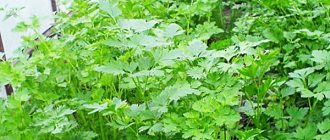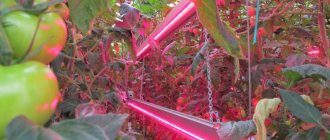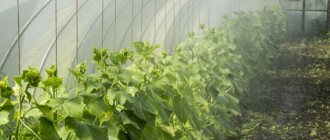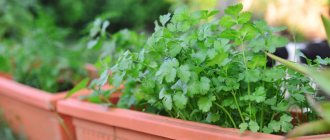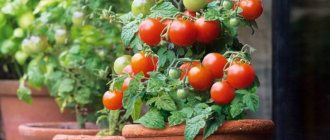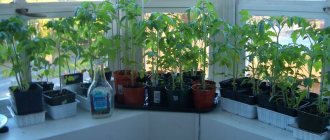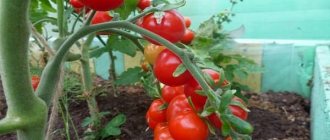You want to eat a fresh tomato at any time of the year. It is for this reason that growing tomatoes in a greenhouse in winter is a topic that is relevant always and everywhere.
Growing tomatoes in a greenhouse is possible with the help of a heating system, artificial lighting, ventilation and irrigation.
However, growing tomatoes in winter is not an easy task. It requires understanding, hard work, dexterity, agrotechnical knowledge and diligence. To grow tomatoes in winter, you need to create suitable conditions for them.
Growing tomatoes in a greenhouse in winter
Having built a greenhouse device with a controlled microclimate, you need to use it wisely. Having invested money, there is no point in getting unprofitable products. For a high yield, you must strictly observe the growing conditions of the tomato plant:
- illumination indicators;
- humidity;
- temperature;
- air speed;
- soil nutritional value.
Features of preparing a greenhouse for winter growing tomatoes
When planning to grow tomatoes in a greenhouse in winter, you should determine the timing of fruiting and obtaining marketable fruit. This is necessary to understand when to sow tomato seeds for seedlings and how exactly to prepare the greenhouse itself.
Soil preparation
For tomatoes you need soil:
- clean from pathogens;
- nutritious;
- neutral or slightly alkaline;
- breathable
If the soil in the greenhouse is not changed from year to year, then loosening, natural materials should be used. For this purpose you can use:
- sawdust;
- straw chaff;
- fresh leaf compost.
Attention! If fresh materials are brought in, they are flavored with ammonium nitrate. Dissolve 2 tbsp in a bucket of water. spoons of fertilizer and water the straw until it is saturated wet.
In the second half of August, the greenhouse is sown with green manure. After 2 months, they are mowed and straw or sawdust flavored with ammonia is scattered over the surface. Next, everything is sprinkled with stove ash 2.5-3 kg per meter and humus 10-12 kg per meter of greenhouse area.
Ideally, if there is time, everything is dug up and left to “ripen” for 1 month.
With the onset of frost and snow, experienced vegetable growers practice covering the greenhouse soil with snow. This will provide the soil with moisture and normalize pathogenic microflora. As heating begins, the snow will melt, the earth will warm up and will be ready to accept tomato seedlings or seeds.
Light mode and ventilation
Each stage of development of a tomato plant requires its own lighting mode:
- emergence phase - 24 hours of light for 3-4 days, until 80% of the seeds sprout;
- seedling phase (until the moment of diving) - 16 hours for 10-12 days;
- after diving, shade for 2-3 days;
- until the seedlings are 30 days old - 16 hours of daylight;
- from one month of age to 60 days - 14 hours.
Note! Daylight should be continuous. It can be increased both in the morning and in the evening, or distributed between them.
Tomatoes also need ventilation during winter growing. She may be:
- manual, natural. Windows open in the side walls or ceiling;
- forced. To do this, use built-in fans powered by electricity;
- hydraulic. Works without electricity due to hydraulic drive;
The choice of ventilation system depends on the volume of the greenhouse.
Temperature
The best temperature for winter growing tomatoes in a greenhouse is between 20 and 25 ℃. if the readings exceed 33 ℃, then the pollen loses its viability. In this case, the pollen is said to be sterile. For the initial stages of growth and development, tomato needs the same temperature parameters.
If the temperature drops below 16℃, growth and development of the bush stops.
Features of preparing seedlings for planting in a greenhouse in winter
If it is necessary to plant seedlings in winter, then sowing is carried out so that by the time of planting the seedlings are 60-65 days old.
The stages of growing seedlings are as follows:
- seed germination;
- preparation of soil mixture;
- filling tubs or individual containers with soil;
- sowing tomato seeds;
- diving during individual cultivation;
- planting in a greenhouse at the fruiting site.
For winter planting of tomatoes in a greenhouse, there are no special requirements for seedlings. As for growing in a garden, it should be:
- healthy;
- stocky;
- have a height of 25-30 cm;
- have short internodes.
Features of caring for tomatoes in a greenhouse in winter
Planting tomatoes in a greenhouse before winter has its own characteristics. With short daylight hours, the main thing is illumination. You cannot produce a tomato crop without the optimal amount of light.
For successful fruiting, you must adhere to the following parameters:
- illumination;
- temperature;
- air exchange.
Watering tomatoes is carried out with warm water in the first half of the day. Fertilizers are often added to irrigation water for feeding.
The first feeding is carried out 10-12 days after planting the seedlings in the greenhouse. The second after 15-20 days, the subsequent ones after the same interval.
Suitable varieties for winter greenhouses
When looking for varieties for use in greenhouse conditions, preference should be given to high-yielding varieties that are resistant to temperature changes:
- The president.
- Hurricane;
- Geranium kiss;
- Siberian dwarf;
- Vasilevna;
- Evpator.
As a rule, several varieties are planted with different ripening periods. In this case, one variety will start the relay race, and the other will pick up fruiting.
Video: Tomatoes in a greenhouse in winter
After watching the video, you can clearly get an idea of growing tomatoes in a greenhouse in winter. Of course, not everything can be adopted and adapted to your own conditions. However, experience shows that even virtual communication with gardeners and greenhouse growers helps to find solutions to their problems.
Video
You can also watch a video where they will show you how to build a greenhouse where you can grow vegetables in winter.
Many gardeners are thinking about setting up winter greenhouses, as this allows them to obtain fresh, healthy products all year round. Of course, you will have to devote more time to caring for the tomatoes, but the result will be excellent and there will be fresh, aromatic tomatoes on the table even in winter.
There are a lot of tomato varieties on the market, with low requirements for lighting and temperature conditions, so choosing the ones you need won’t be difficult.
Secrets of flower pollination
There are no special secrets to pollinating flowers for indoor or greenhouse conditions. The tomato is a self-pollinating crop; it pollinates perfectly without human help. An exception can only be when the temperature rises above 32℃; this is not relevant for the room.
However, experienced gardeners have noticed that with regular “pulling” of stems with blossoming flowers, pollination and fruit set proceed better. It is enough to lightly tap the stem and then spray the flowers with water from a spray bottle.
Science has gone further and recommends spraying tomato bushes during budding with a 0.1% boric acid solution. To do this, it is enough to use a miniature sprayer to treat the tips of the shoots and buds to a state of light moisture. Such treatments should be carried out once every 10-12 days. There is no point in re-processing the same buds.
Equipment
Growing tomatoes as a business is not too expensive. At the initial stage, large investments are not required, so anyone can try their hand at this business.
As for the equipment, first of all, you need to build a greenhouse, provide water, light and heating. The greenhouse must maintain positive temperatures during the cold season for the tomato crop to fully ripen. In addition, tomatoes need constant watering, so you need to provide water and proper lighting to the room where the vegetables will be grown.
In addition, you will need containers for harvesting and storing the crop.
That's basically all the equipment you'll need.
Tomato diseases in winter
In indoor and greenhouse conditions, tomatoes can also be susceptible to diseases. During the seedling period, black leg is dangerous. To avoid this, you need to maintain optimal microclimate and watering conditions.
During the fruiting period, a tomato may be affected by:
- late blight;
- Alternaria blight;
- cladosporiosis;
- anthracnose;
- powdery mildew.
Attention! By following the rules of agricultural technology, damage can be avoided.
Modern plant protection products are quite effective. Using them for preventive purposes can prevent the emergence and spread of diseases.
The following have proven themselves to be the most effective:
- Baktofit;
- Quadris;
- Trichodermin;
- Topaz;
- Byleton;
- Pseudobacterin-2;
- Fitosprin -M.
A careful examination of tomato bushes and timely diagnosis of the disease will help to quickly identify and treat the bushes. Pay attention to the instructions for the drug and especially the waiting period during fruiting.
Advantages of winter planting
How to propagate anthurium at home photo video
Many novice gardeners are skeptical about planting tomato seeds in practically frozen ground. In fact, this method has many advantages.
- Tomatoes in a greenhouse will harden in winter, so they will not be afraid of late blight. As well as light frosts.
- They do not need to be pre-soaked and treated with fungicides and chemical growth stimulants. Frosts will kill all bacteria that could be on the planting material.
- Melt water will help the seeds adapt, protect them from bacteria, and serve as a natural growth stimulator.
- Shoots will begin to appear at the right time; the seeds know better than agronomists when they need to hatch. Often, winter seedlings outstrip grown seedlings in growth.
- The resulting plants are strong and healthy. They have a well-developed root system and do not need picking.
- You can harvest a richer harvest from such tomatoes, even if it’s a dry summer. This is explained by the fact that the roots of tomatoes planted before winter grow in depth and not in breadth. They can tolerate lack of rain and watering.
- A significant saving of time and effort, because in the spring the gardener already has a lot to do. When planting tomatoes in the fall, you don’t need to grow seedlings or think about how to get them to the garden in the spring.
Feeding for proper development
If seedlings are grown in universal soil, then they do not require fertilizing. After planting in the place of fruiting, after 12-15 days the plant needs to be fed with a solution of ammonium nitrate 1 tbsp. spoon in a bucket of water or superphosphate in the same concentration.
The second and subsequent feedings can be carried out after 15-20 days. The last feeding is carried out 2-3 weeks before the end of fruiting.
Fertilizing that alternates organic and mineral fertilizers gives very good results.
For organic feeding you can use:
- faeces from cattle, pigs and horses. Solutions are prepared in 1 kg per bucket of water;
- chicken droppings. The concentration is maintained at 0.5 kg per bucket of water;
- compost infusion 2-3 kg per bucket of water with standing for 3-4 days.
Note! Experienced vegetable growers have noticed that fertilizing with less concentrated solutions, but more often, gives higher yields.
There's no point in trying too hard. Overfeeding is just as dangerous as underfeeding. It will immediately affect your appearance. Eg:
- yellow leaf. It can be due to both nitrogen and calcium deficiency. However, in the first case the process begins from the lower sheet plates, and in the second from the upper ones;
- a wrinkled leaf indicates overfeeding with calcium and potassium is not absorbed;
- a thick, dense, hard leaf indicates sulfur deficiency;
- A yellow outline along the edge of the leaf indicates a magnesium deficiency.
Soils are rich in nutrients. If in doubt, it is better not to use fertilizer.
How to prepare seedlings
Winter tomato seedlings are special seedlings. It is grown in the fall so that it is ready for planting by early November. If for some reason it is impossible to plant seedlings in November and they must be preserved until January, then in this case there are rules on how this can be done. To do this, the seedlings need to be periodically watered with heated water and kept at a temperature of 20-22 degrees Celsius.
At least 2 weeks before planting the seedlings in the greenhouse, the soil should be watered with heated water. In addition, try to keep the air temperature in the greenhouse at least 20 degrees Celsius at this time.
The temperature range for seedlings should be strictly maintained.
Having planted seedlings, it is imperative to feed them with several types of mineral fertilizers, which were mentioned earlier.
How to plant seedlings? In general, there is nothing difficult about planting tomato seedlings in a greenhouse.
It is clear that healthy seedlings are selected for planting, and sick or spoiled ones are rejected. After the seedlings have been selected, they are planted in the holes in straight rows. The optimal distance between each seedling should be approximately 50 cm.
When the seedlings are planted, they are tied with twine to a wire stretched along the row. That's all the wisdom.
Return to contents
What difficulties may arise
When planting tomatoes before winter, you may encounter a number of difficulties. The following is relevant for the greenhouse:
- inability to regulate temperature and humidity. To monitor these parameters, you should use thermometers and hygrometers. However, they cannot show information in the entire greenhouse and some of the plants may suffer;
- illumination. In winter, the greenhouse should be equipped with backlight lamps. Otherwise, the plants will stretch;
- diseases. If the soil and the entire greenhouse structure are not treated after use last season and plant diseases are observed, then there is a high probability of recurrence. Before use, you should use sulfur bombs, disinfection and disinsection means, and change the soil;
- fragility of the structure. Heavy snow often reduces the work of a vegetable grower to zero. Constantly removing snow from the roof of a greenhouse is a mandatory procedure. You should not allow roof failures - this can lead to the loss of the entire crop.
The living room is not a perfect place for fruiting tomatoes. Difficulties in growing indoor varieties may be the following:
- yellowing and falling of leaves and ovaries. The cause may be dry air, low light, high temperature or dry soil. By eliminating the causes, the tomato will quickly recover;
- the plant is booming. The stem becomes powerful and thick. The leaf is bright green and huge. Stepchildren grow quickly and are “fat”. At the same time, the flowers are small and the brush is very weak. Everything points to nitrogen overfeeding. In this case, you need to increase the temperature, do not water the plant for 6-7 days, and pollinate the flowers manually with a brush. Next, carry out abundant watering with clean water and drain it into the pan;
- the plant “withers” for no apparent reason. Pay attention to drafts (windows, windows) and possible gas contamination. Perfumes are not tomatoes' best friend. Sometimes close proximity does not allow the plant to develop evenly and begin to bear fruit. The same can be said about the neighborhood with indoor plants.
Each apartment and room is its own little world. You can’t foresee all the difficulties in advance, but you can monitor the condition of the tomatoes. They themselves are quite capable of suggesting solutions to problems.
Convenient sowing we sow the garden bed
The previous method has one drawback - the seedlings obtained from such planting grow too densely and are not very convenient to work with. Therefore, many gardeners prefer to plant seeds in the traditional way. Tomatoes do not like deep planting, so there should be no more than two centimeters of soil above the seeds. For the winter, you should sow thicker than usual, since the germination percentage is often lower than with standard planting. Do not spare the seeds - it is better to pull out weak plants, leaving only the strongest shoots. To protect planting material from frost, a layer of mulch should be laid over the bed.
A layer of mulch to protect planting material from frost
Seeds should never be soaked before planting - this procedure is acceptable in the spring, but in this case it would be completely inappropriate. Melt water and frost will work no worse than potassium permanganate and other newer preparations for seeds. There will be enough moisture in the soil for them to start growing with the first rays of the sun.
Tomato seeds for planting in winter
Choosing the time of planting before winter is the most difficult moment. Seeds should not be sown in warm weather to avoid causing them to germinate prematurely. For the same reason, thaws are also dangerous. There is only one way out of this uncertain situation - prepare the bed in advance (loosen the soil, spread compost), mulch, and as soon as the soil freezes a little, sow the seeds and cover the bed with mulch. Then, even during a thaw, the cold will remain under the mulch layer for a long time, keeping the seeds from germinating.
Basic recommendations for growing tomatoes in winter
When thinking about growing tomatoes in winter on a balcony, greenhouse or room, make a plan. It must spell out each point of agricultural technology and possible ways to comply with it. If at least one point cannot be accomplished, put the idea aside for a while. It will be a pity if the plant dies. As soon as you can fully satisfy the needs of the tomato during growth and fruiting, you can begin sowing.
When growing in a greenhouse or room, sometimes there is a need to accelerate the formation and development of fruits. To do this, use the technique of tearing the roots. The whole plant is pulled up, as if pulled by the trunk from the tub. At this time, the small roots are slightly undermined. Afterwards, the bush is watered abundantly and lightly hilled. The plant rapidly begins to grow, forms an ovary and produces fruits.
Attention! The “acceleration” procedure can be performed on a bush only once.
To control the microclimate, get measuring instruments. It is impossible to determine the ambient temperature by eye. It is even more difficult to determine humidity. Take care of additional lighting lamps and heating devices in case of unforeseen circumstances in winter.
Transplantation and formation of a bush
The transplant is carried out as follows.
- For two days, water the seedlings abundantly.
- Make holes at a distance of approximately 50 cm from each other. If the variety has a thick stem, then increase the distance to 70 cm. Usually, a two-line ribbon pattern is chosen.
- Pour at least half a liter of water into each hole.
- Dig up the soil in each pot using a stick, turn the pot over, taking out a lump of earth with roots.
- The seedlings are buried along the cotyledon to allow the root system to develop.
As the tomatoes grow, they will need pinching and staking. It is convenient to use trellises in a greenhouse, attaching the stem to them using clips. You can also tie the plants with twine, attaching the upper end to a wire running under the ceiling.
The lower leaves must be removed and the soil regularly loosened to ensure oxygen supply to the roots. To increase the number of ovaries, you can use special drugs - fruit formation stimulants.
If the variety is indeterminate (high-growing), then it is grown in one stem, removing all the stepsons. When it reaches two meters, the top is pinched. For medium-sized tomatoes, one uppermost stepchild is left. Low-growing varieties are usually not used for growing in winter in greenhouses.
Miracle on the balcony
The “Balcony Miracle” tomato has gained special love among gardeners at home.
This is a compact determinate variety, up to 50 cm high, ultra-early ripening (maximum ripening period 90 days), the weight of each bright red tomato is up to 65 g, round in shape. The usual yield is up to 2 kg per bush. If the plant is “allocated” to a larger area, the harvest in winter can be higher. Before germination, the seeds are grown in greenhouse conditions, then the temperature is reduced to 15 degrees for a week, then raised again. When the sprouts rise to 15 cm, they are planted in large containers. “Balcony Miracle” tomatoes love light (although they ripen even in conditions of its deficiency) and do not require tying up or removing shoots.
A positive effect during winter cultivation will be provided by: assistance in pollination, good watering, fertilizers, careful loosening of the soil, and the formation of a bush.
Feeding options:
- Special drugs.
- Liter solution: 5 g of superphosphate, mixed with potassium sulfate and urea - 1 g each.
Growing a “Balcony Miracle” at home will allow you to collect excellent tomatoes from your windowsill in winter for salads, preparations, and even freezing.
Ampel varieties
In addition to standard varieties, ampel tomatoes are also in demand among fans of indoor tomato cultivation. They can be planted in hanging flowerpots or in tall pots, from which the shoots will hang beautifully on the windowsill. Caring for them is a little more difficult than conventional varieties, and the yield is lower, but all this is compensated by the excellent taste of the tomatoes and the high decorativeness of the bush. The choice of hanging varieties is still small, and seeds can be purchased only from a few domestic agricultural companies.
| Name | Characteristics |
Garden Pearl | A spreading bush with shoots up to 50 cm. The stems of the plant are thin, but strong, and do not break under the weight of numerous fruits. There is no need to prun the bush. Round tomatoes weighing 15-20 g when ripe acquire a crimson color and become translucent. One plant can have up to three hundred marketable fruits. The variety is very decorative, feels great indoors and outdoors. |
| City dweller F1 | Spectacular early ripening hybrid. It can grow vertically (but then the stems need to be tied up) and as an hanging plant. Its tomatoes are round, red, with a characteristic tomato taste, weighing about 30 g. The hybrid is specially bred for growing indoors, so it develops well and bears fruit regardless of the time of year |
| Cherryfingers F1 | A new productive hybrid for ampel growing. The shoots are sparsely leafy, up to half a meter long, strong. Small red fruits have an elongated shape, attached to long clusters of 8-10 pieces. Tomatoes are suitable for harvesting for the winter; they do not crack during heat treatment. In good conditions, the yield of one bush is 1.8-2 kg |
Tumblr | One of the new ampelous varieties. Very early, has a cascade bush shape, the weight of the tomatoes is 25-30 g. The fruit has an excellent taste, the average yield is about 2 kg. With a lack of lighting, the number of fruits is slightly less |
Mascot | Already a fairly well-known ampelous variety of domestic selection. It belongs to the mid-early variety, the bush is quite compact, shoots up to 55 cm long. The egg-shaped fruits are red in color, average weight is about 40 g. When grown in open ground, the weight of the fruit is almost twice as much. The variety is distinguished by extended fruiting, and very abundant. The tomatoes are juicy, tasty, and can be canned |
Red Abundance F1 | A very attractive productive hybrid. The shoots grow up to 60 cm; the plant does not need pinching. The clusters are densely hung with small (20g) sweet red fruits, which are suitable for canning. The bush grows quickly, so it needs a lot of space. In winter, the plant must be illuminated, otherwise the yield will decrease |
